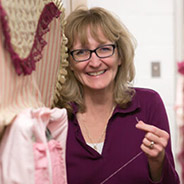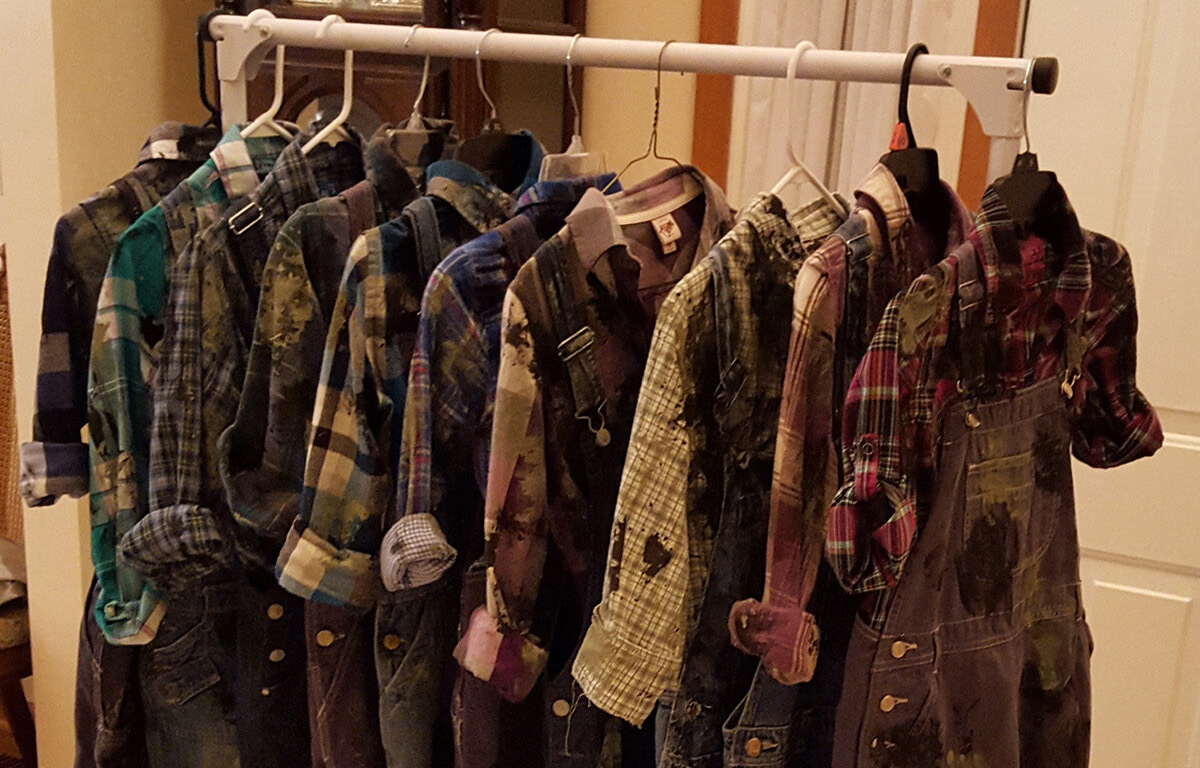Faculty and Staff Spotlight: CHEAR project senior manager discovers creativity in costuming

(Originally posted in The University Record)
The first time Julie McCormick volunteered to help with costumes was for a show more than a decade ago, when her son, then a third grader, got a part in a children’s production in Howell.
“When your child participates in theater, you typically have to do some volunteer work. I chose to help with costumes, which was funny because I had no idea how to sew. But I did know how to use a glue gun,” said McCormick, project senior manager at Child Health Evaluation and Research Center in Michigan Medicine.
Shortly after that, the show director — who was also a middle school principal in Brighton — approached McCormick about overseeing costuming for the middle school’s upcoming production of “Shrek.”
She agreed, thinking her son could get a role in the play and it would be a fun way to be involved in a production together.
“Then my son decided not to audition,” she said, laughing.
McCormick oversaw the show’s costumes anyway, had a ball, and a new hobby was born. To date, she’s helped oversee and produce costuming for nearly a dozen productions.
What it takes to costume a show
In local community theater, overseeing costumes is a bit like project management, something McCormick knows a lot about, thanks to her role at CHEAR.
For most of the shows she’s worked on, McCormick has collaborated with two other women who began as costuming colleagues, then became close friends. Today, they work as a team.
“About four months before a show is scheduled to open, we get the script. We read through it and identify the period and location for the show, like 1930s England. Then we start looking for inspiration online and in books,” McCormick said.
Next, they identify what characters will wear in each scene, with one consistent mandate.
“You never want the costumes, especially for children’s shows, to take away from the actor,” she said.
Several weeks later, after auditions, McCormick and her two partners get a cast list and begin to take the actors’ measurements. That process inevitably leads to some costume revisions.
“In our initial planning, we may be thinking we’re going to have a small female in one role, but the director casts a large male. It happens all the time,” McCormick said.
“We develop a spreadsheet that includes each scene and each cast member, all their measurements, and what they will need to wear in each scene. We also consider how to enable quick changes. Velcro is in, buttons are out. This spreadsheet can include 40 or 50 actors and several hundred costumes.”
Finally, McCormick and her team divide up who will oversee each costume, and they discuss which items will be made, which rented, and which can be bought cheaply on Amazon. Then every week for the next two months, they check in and lend a hand (or glue gun), as needed.

Bringing a production to life
A month before opening night, McCormick and her partners host a try-on session with the cast.
“We bring all the actors on stage in costumes for each scene, and we look at whether the costumes work well together, and if the actors are comfortable and able to move around in what they’re wearing,” McCormick said.
“It’s also then that we might realize a hem is too long, a hat covers too much of someone’s face, or a child actor took a growth spurt, and their pants and sleeves are now too short.”
Adjustments are made, and costumes are tried on again during dress rehearsals for any final tweaks. On opening night, McCormick or one of her partners will work backstage, trouble-shooting.
“A button inevitably pops off, something goes missing, a costume gets wrinkled, or someone needs help with a quick costume change,” she said.
“But we do take turns working backstage, so we all have an opportunity to watch the show.”
An unexpected blessing
While McCormick was always pretty handy with a glue gun, her costuming journey also enabled her to develop solid sewing skills, as well as forge a stronger bond with her mother.
“My mom was an amazing sewer. She was a talented quilter and could do anything with a sewing machine. She had like three of them,” McCormick said.
When McCormick first began volunteering to costume, she turned to her mother for some help.
“She was happy to sew several things for me. Then she showed me how to thread a sewing machine, and after I bought my first sewing machine, she showed me how to use it,” McCormick said.
“Eventually, working on my shows became a thing for us to do together. And as I got better at sewing, she asked me to help her with some quilts.”
During the pandemic, McCormick’s mother made quilts for friends, and she and McCormick would set up a table 6 feet apart, wear masks and quilt together. McCormick’s father would also help by ripping out seams, as needed. It became a family affair.
“Without the costuming, which led to the sewing, I wouldn’t have spent nearly as much time with her. It was an amazing gift,” said McCormick, whose mother died three years ago from mesothelioma.
The joy of costuming
In addition to giving her treasured time with her mother, McCormick said her years of costuming have been energizing and fulfilling.
“One of my favorite aspects of costuming is working with young kids who are building their confidence. It’s tough to get on stage and sing and dance when you’re 7 years old. But costumes help them develop their character and gain that confidence, so being part of that process is rewarding,” she said.
McCormick’s costuming hobby also gives her a break from the stresses of everyday life and acts as a risk-free creative outlet.
“There’s no pressure to be perfect,” she said. “I can just enjoy the process and don’t really have to worry about the consequences. There’s no way for things to go terribly wrong,” she said, laughing. “I mean, you can get a run in a pair of tights or lose a hat, but these are easy things to solve.
“As we always say, the costumes just need to look good to the audience, who are about 30 feet from the stage.”
